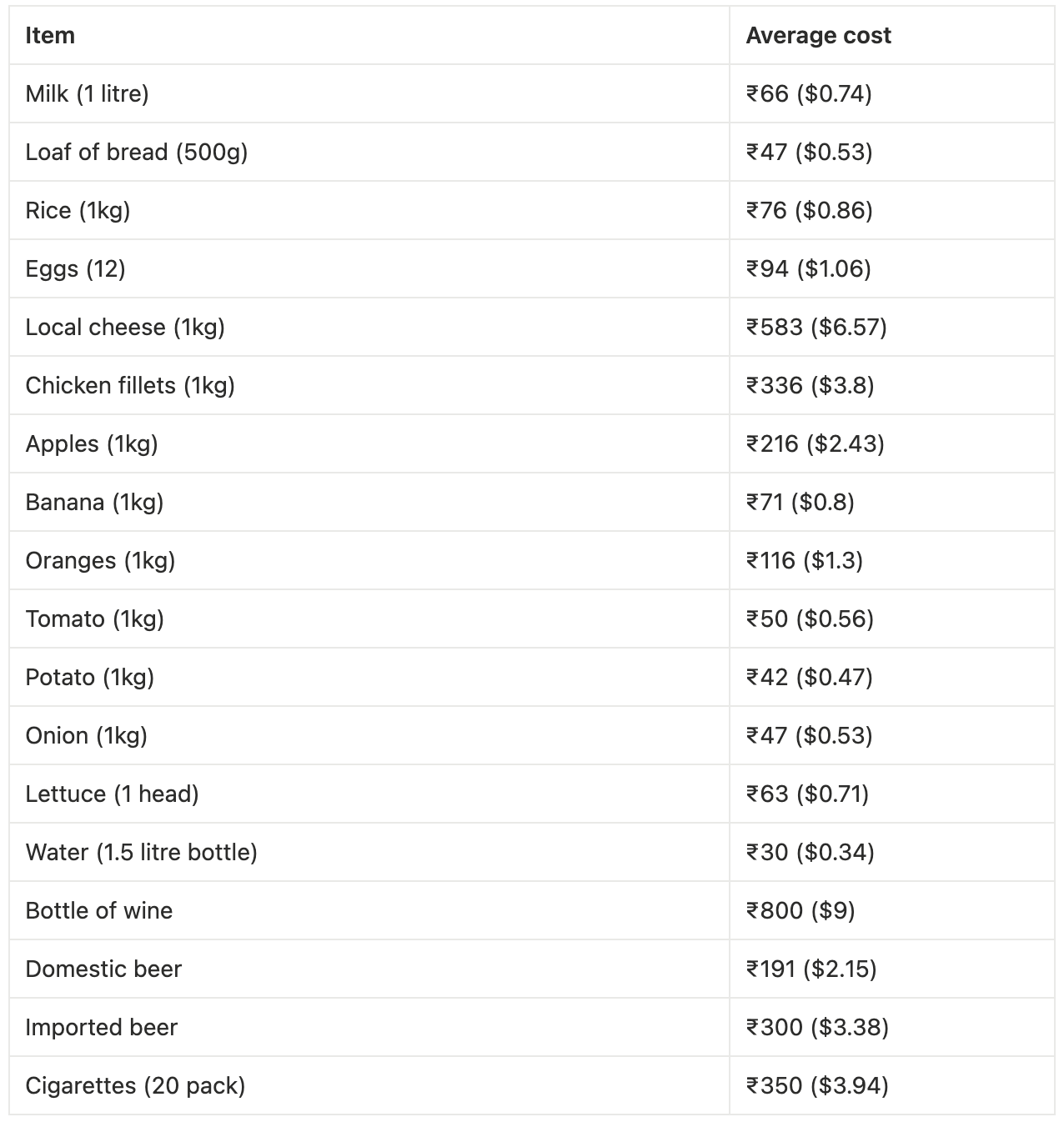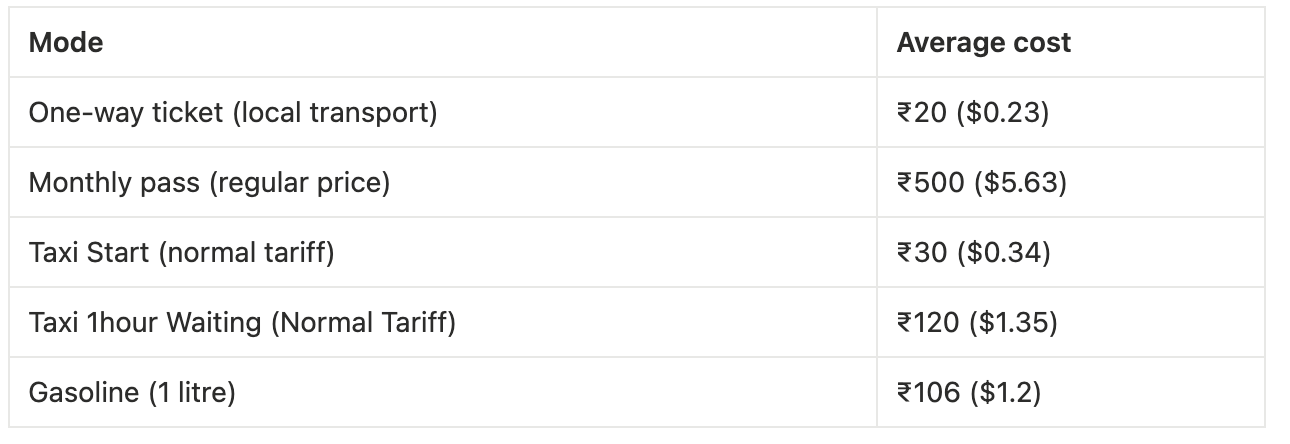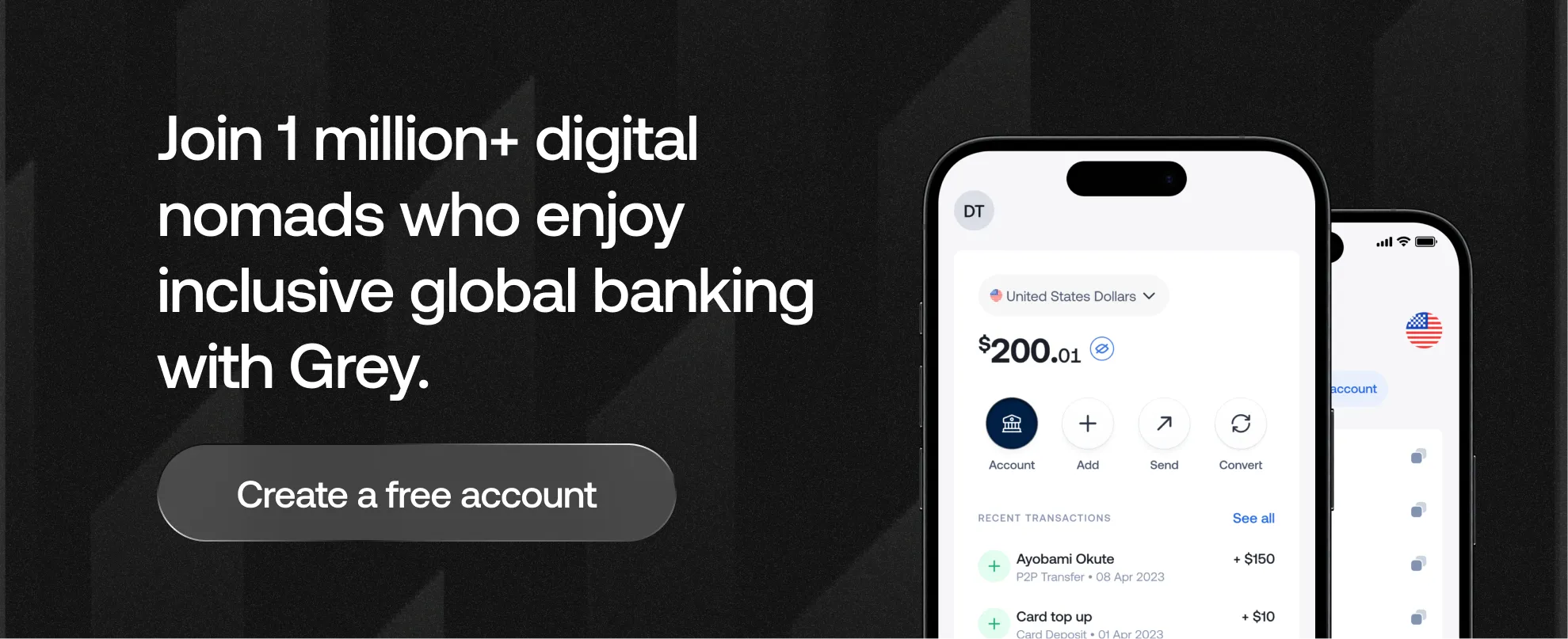

The more you know, the more you realise that you don’t know. This saying is attributed to the great Aristotle. He may not have been talking about Mumbai, but he just as easily could have been.
The city has that effect on people. Just when you think you’ve figured it out, you learn something new. Mumbai is a city that overwhelms your senses but finds a way to make you fall in love with it anyway. It’s India’s financial capital, a melting pot of dreams, and of course, the home of Bollywood.
If you’re considering moving there, understanding the cost of living is the first step to finding your place in the city that never really slows down.
Let’s break it all down. We’ll do housing, groceries, transport, utilities and every essential thing you need to know about how much it costs to live in the city of flamingoes.
Rent in prices in Mumbai aren’t exactly straightforward. There’s a lot of contrast depending on what part of the city you stay. So it’s heavily dependent on the lifestyle, neighbourhood, and how much of Mumbai you want to properly immerse yourself in.
If you plan on staying in the south, you’ll most likely be close to the sea, which can push up the rent. If you move further out to places like Thane, Navi Mumbai, or even Andheri, things start to look friendlier on the wallet. The commute might stretch a little, but with Mumbai’s expanding metro network, that trade-off’s becoming easier every year.
Here’s a quick look at what renting in Mumbai actually costs on average:

If you’re thinking long-term and planning to buy rather than rent, brace yourself. Mumbai’s property market is as intense as the city itself. So think long and hard and decide if it’s a commitment you want to make.
The city’s real estate scene is famously competitive. In South Mumbai, there are neighbourhoods where proximity to the sea and skyline views can easily double the cost per square metre. Folks who buy property here usually do it for comfort and prestige.
If you have a tighter budget, areas like Navi Mumbai, Thane, and Chembur are redefining urban living have significantly lower property prices. These neighbourhoods attract young professionals and families looking for value without losing touch with the city’s pulse.
Still, property ownership in Mumbai is no small feat, regardless of where you chose. Mumbai remains one of India’s most expensive and fast-moving real estate markets.
Here’s a breakdown of the average cost of buying an apartment in Mumbai:

Also read: Cost of living in New Delhi
I know you’re probably trying to save money, but you can’t move to a new country without properly immersing yourself in it. And what better way is there to immerse yourself in the culture of a people than through their food?
Mumbai has options for every kind of budget and craving.
A full meal at a small local eatery can cost as little as ₹150 - ₹500, making it easy to eat well without overspending. Mid-range restaurants, the kind you’ll find in Bandra, Powai, or Lower Parel, usually charge around ₹1,500 - ₹2,500 for two people, while fine dining establishments in South Mumbai can easily cross ₹5,000 - ₹8,000 for a three-course meal.
Fast food and café culture are also big parts of daily life Mumbai. A McDonald’s combo meal costs around ₹400, a cappuccino averages ₹230, and a bottle of water costs roughly ₹17, give or take. Meanwhile, imported drinks or craft cocktails at upscale bars can range from ₹350 - ₹900 depending on the location and brand.
What’s especially interesting about Mumbai’s dining scene is how it blends affordability and aspiration. On one street, you can find a family-run thali joint serving unlimited curries for the price of a metro ticket, and right next door, a sleek restaurant serving modern Indian tasting menus that could rival Paris or New York. Just pick what works for you and have a good time.
Here’s a breakdown of the average cost of eating out in Mumbai:

Also read: Cost of living in Bengaluru (Bangalore)
The smell of spices spilling from open sacks, and the sight of produce piled high in street markets, are things that are synonymous with Mumbai. The city’s markets mirror its people. They’re diverse, adaptable, and endlessly resourceful.
For most residents, groceries make up about 10% - 15% of their monthly expenses, depending on lifestyle and household size. I know for sure that mine would be less than 10%. I eat out a lot as I rather unfortunately, can’t cook.Local staples such as rice, lentils, vegetables, and bread remain relatively affordable, with prices that fluctuate slightly based on season and supply. Buying directly from open-air markets or smaller vendors often stretches your rupee further than shopping exclusively at premium stores. Imported goods can cost two to three times their local equivalents, which is why many Mumbaikars (a person residing or born in the Indian city of Mumbai), ****mix local essentials with the occasional indulgence.
One important thing to note: beef is largely unavailable in Mumbai due to local religious and legal restrictions. Cows are considered sacred in Hinduism. Most households substitute with chicken, fish, or mutton, and the city’s coastal location ensures seafood remains a staple in many diets, especially along the western suburbs.
For the average single professional, monthly grocery bills typically range between ₹5,000 - ₹10,000, while families might spend upwards of ₹20,000 - ₹30,000 depending on preferences and eating habits. Despite global inflation and rising urban costs, Mumbai’s mix of traditional markets and modern retail options keeps grocery shopping flexible.
Here’s what everyday market prices in Mumbai look like on average:

Also read: Cost of living in Bali: what remote workers and expats should expect
Getting around Mumbai is both a logistical exercise and a lesson in patience. But it’s also part of what gives the city its pulse. The local train network is often called the city’s lifeline, and for good reason too. It moves over 7.5 million passengers daily across its Western, Central, and Harbour lines. It’s the fastest and most affordable way to get around, with tickets costing as little as ₹20 for short distances. You don’t want to be on the train during rush hours though. They are usually packed.
For shorter journeys, auto-rickshaws, locally called “tuk-tuk”, and black-and-yellow taxis are everywhere. A quick rickshaw ride across the suburbs might cost between ₹30 and ₹150, depending on distance and traffic, while taxis are a slightly pricier but more comfortable alternative. The city’s Uber and Ola network is extensive too, though surge pricing during heavy rains or traffic jams can double the fare.
Public transport users typically spend around ₹2,000 - ₹3,000 per month, depending on routes and frequency. Those relying on taxis or private cars could easily see transport costs rise to ₹8,000 - ₹15,000 monthly, especially with petrol prices hovering around ₹106 per litre and parking charges creeping upward in business districts like Lower Parel or Bandra.
You could also get your own car. Between fuel, maintenance, and parking, monthly costs can exceed ₹12,000 - ₹20,000, depending on usage. So most residents prefer a hybrid approach, combining public transport with occasional cabs or two-wheelers to strike a balance.

Once you’ve found your place in Mumbai, your next concern will likely be managing monthly utilities. This will vary widely based on your lifestyle.
For most residents, electricity is the biggest recurring expense. Mumbai is generally hot and humid, so air conditioning is almost non-negotiable during the summer months. A small apartment using fans and minimal AC might see monthly electricity bills between ₹2,000 - ₹3,500, while larger households running multiple air conditioners could pay anywhere from ₹5,000 - ₹10,000 or more. The average unit rate for electricity in the city ranges from ₹7 - ₹12 per kWh, depending on consumption slabs and provider (BEST, Adani, or Tata Power).
Water and waste management are generally more affordable but vary depending on your housing society. Monthly water charges typically range between ₹300 and ₹800, and some buildings include it in maintenance fees. Waste disposal and building maintenance can add another ₹1,000 - ₹3,000, particularly in gated communities or high-rise apartments.
Internet connectivity in Mumbai is among the most reliable in India. With high-speed fibre connections from providers like JioFiber, Airtel Xstream, and ACT you can get speeds between 100 Mbps to 1 Gbps. Most monthly plans start at about ₹700 - ₹1,500. Freelancers and remote workers often opt for mid-range packages that balance speed and stability, typically around ₹1,000 per month.
For mobile data, plans from Airtel, Jio, and VI start at around ₹300 - ₹500 per month for unlimited calls and up to 2GB of daily data, making it easy to stay connected without breaking the bank.
Altogether, a single professional living in a one-bedroom apartment might spend roughly ₹4,500-₹7,000 per month on utilities, while families in larger apartments can expect anywhere between ₹8,000 - ₹15,000, depending on usage and comfort level.

If staying active is a priority, you’ll find a wide range of fitness options across the city. Basic gym memberships in local neighbourhoods start around ₹1,200 - ₹2,500 per month, while premium chains like Gold’s Gym, Cult.Fit or Fitness First charge between ₹3,000 - ₹6,000 monthly.
Outdoor enthusiasts often take advantage of Mumbai’s coastline and public spaces. Early morning jogs along places like Marine Drive or Carter Road are pretty common. Cycling is also very popular. These activities are mostly free, apart from park entry fees (around ₹50 - ₹100).
For those with a competitive streak, sports club memberships can range dramatically from ₹10,000 annually for smaller community clubs to over ₹1 - 2 lakh per year for prestigious venues like the Bombay Gymkhana or CCI (Cricket Club of India). Renting a tennis or badminton court for an hour typically costs ₹600 - ₹1,200, depending on the location and time.
A standard cinema ticket for an international release ranges from ₹250 - ₹600, although luxury theatres like PVR ICON or INOX Insignia charge up to ₹900 for recliner seats.
In short, there’s something for every kind of lifestyle. You can live simply and spend next to nothing, or indulge and experience the best of urban leisure. The choice, as always in Mumbai, depends on how much you want to spend.

Also read: Cost of living in Jakarta: a complete guide for travellers and digital nomads
For families, education is one of Mumbai’s biggest expenses. While local preschools are relatively affordable, international schools are significantly more expensive due to global curricula and facilities. Still, many expat and professional families consider the investment worthwhile for quality and continuity.

If you’re shopping on the high street, international brands like Zara, H&M, Levi’s, and Uniqlo have a strong presence in malls like Phoenix Palladium and Oberoi Mall. A pair of jeans typically costs around ₹2,500 - ₹4,000, casual shirts or blouses range from ₹1,200 - ₹2,500, and summer dresses or chinos fall within the ₹2,000 - ₹3,500 bracket.
For mid-range or local brands, men’s t-shirts and women’s kurtas often cost ₹800 - ₹1,500, while workwear or ethnic outfits average ₹2,000 - ₹3,000. Many locals also shop at Linking Road (Bandra) or Hill Road, where you can bargain for trendy pieces, sandals, and accessories, usually for under ₹1,000.
When it comes to footwear, expect to spend around ₹2,000 - ₹3,500 for a good pair of sneakers, while local brands or markets sell stylish alternatives for ₹800 - ₹1,200. During the monsoon months, rubber sandals or waterproof shoes are a must-have and usually cost between ₹500 - ₹1,000.
The city’s fashion culture encourages you to stay cool, stylish, and comfortable.

LDMAG1
To live a proper life in Mumbai, you need to plan, budget and work towards it. It’s a city that rewards ambition. It encourages you to push yourself, to work, to thrive. But there’s only so much you can do without the right tools. Managing your money, especially as someone who gets paid in foreign currency is important. And in Grey, you have the perfect solution.
With Grey, you can create a multicurrency account to receive, convert, and spend money across borders seamlessly. Grey helps you manage it all from one platform with real exchange rates and no hidden fees. So you don’t need to worry about payments. You can pay for everything you need in this new city, right from your app.
Sign up or download the Grey app today and make managing money in Mumbai easier.
Disclaimer: This article is based on researched data and is intended to give readers a general overview of the cost of living in Mumbai. The figures provided are estimates gathered at the time of writing and may vary depending on location, lifestyle, and market changes.




.svg)
Back to top